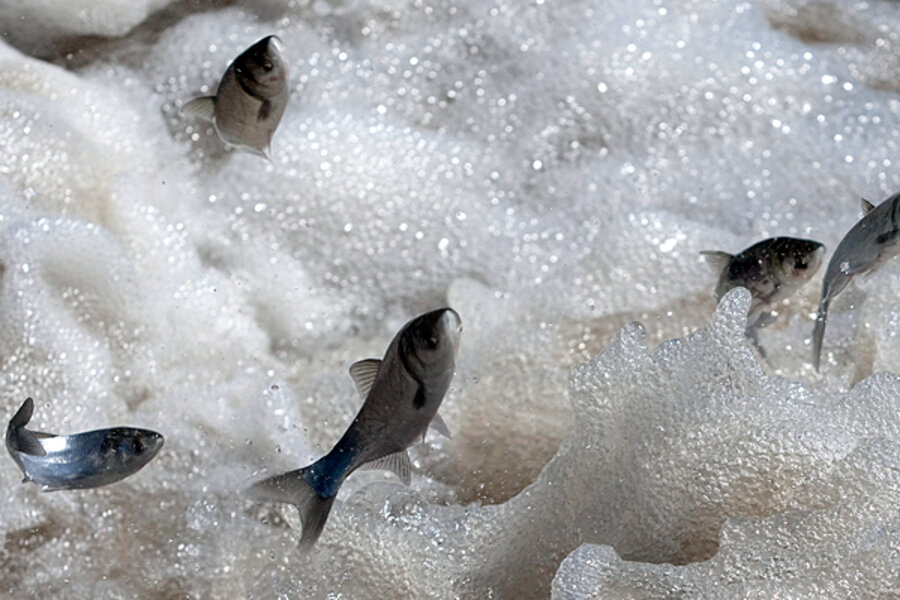Will Asian carp turn up in fishing expedition near Lake Michigan?
Loading...
| Chicago
Federal officials are starting a four-day intensive fishing expedition Monday to determine whether the Asian carp has infiltrated water locks that are designed to keep the invasive species from entering Lake Michigan, a scenario that neighboring states say would wreak havoc on the lake’s fragile ecosystem.
The search effort is in response to discoveries of Asian carp DNA in June and July, all in Lake Calumet, a body of water located about six miles below Lake Michigan but directly connected to it through the Calumet-Sag Channel. That waterway intersects the Chicago Sanitary and Ship Canal, a man-made channel that connects Lake Michigan with the Mississippi River.
Biologists from the US Fish and Wildlife Service, the US Army Corps of Engineers, and the Illinois Department of National Resources will join commercial fisherman and biologists from Southern Illinois University in the expedition through Lake Calumet and surrounding waterways. Their activities will include laying half-mile-wide nets to sweep large portions of the lake as well as sampling fish along the shoreline through electrofishing. The search is scheduled to continue through Thursday.
The expedition, says John Goss of the White House Council on Environmental Quality, who is leading the effort, is to determine if the DNA discoveries warrant further action. It will also investigate other possible reasons that the species may have entered the Chicago waterway system, such as fishermen using it as bait.
In June 2010, a 19-pound Asian carp was fished out of Lake Calumet. This is the only live sample of the species to date, but environmental groups and states neighboring Illinois argue that dozens of DNA samples taken in recent years show that an electric barrier, located about 35 miles downstream from Lake Michigan in the Chicago Sanitary and Ship Canal, is not enough to keep the Asian carp out.
In all, 85 DNA samples taken since 2009 have tested positive for Asian carp, according to the Chicago office of the US Army Corps of Engineers.
This includes positive tests in recent months. On June 15, seven positive DNA samples were taken, followed by two more on July 12 and another two on July 19. During this time period, a total of 328 water samples were taken, according to the Asian Carp Regional Coordinating Committee, a multi-agency effort created in 2009 and tasked with monitoring and controlling the movement of the species.
Federal officials, including Mr. Goss, continue to insist that the DNA evidence does not conclusively show that the Asian carp is close enough to be a threat. They say that sampling may have involved dead fish or water that was transported in from another region. Before the June discoveries, they say, eight monitoring trips since March had yielded evidence of 4,500 fish in the water – none Asian carp.
But critics from states that neighbor Illinois say the DNA evidence is enough to show a systemic problem, which they say will only grow worse with time. Ongoing legal challenges keep surfacing with the same aim: permanent closure of the two shipping locks in the Chicago River and Calumet-Sag Channel to prevent the Asian carp from potentially destroying what the states say is a $7 billion annual recreational and commercial fishing industry.
The Obama administration, they say, has been too slow to address the issue and is siding with the barging industry, which is against the lock closures.
Michigan is currently leading a federal lawsuit, with support from Wisconsin, Minnesota, Ohio, and Pennsylvania. In 2010, as part of the suit, the US Supreme Court and a US district judge denied requests to immediately close the locks. Other parts of the lawsuit are now working their way through the courts.
“We often wonder after a tragedy if there had been any warning signs that we missed. We now have 85 warning signs that Asian carp are an impending tragedy for the Great Lakes,” said Michigan Attorney General Bill Schuette in a statement late last week. “We don’t need any more studies. We need to act.”
Environmentalist groups such as the Alliance for the Great Lakes also say that the DNA testing is enough to show a problem.
“The nail-biter is hoping that this intensive monitoring effort does not turn anything up. That would mean they’re most likely there in very low numbers, [but] the more you find, the more critical the situation is for Lake Michigan,” Joel Brammeier, president of the Alliance for the Great Lakes, told the Associated Press.
The Asian carp is a bottom-feeder fish that was introduced to catfish farms in Mississippi and Arkansas in the 1970s to help control algae growth. The fish is presumed to have traveled to Chicago through the Mississippi River.





